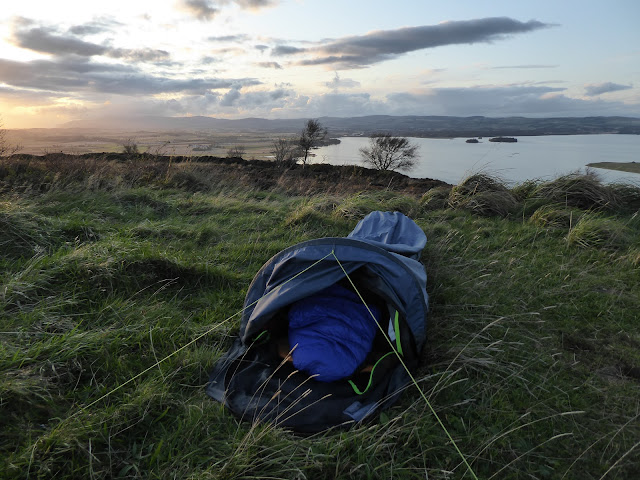When I first started camping nearly 30 years ago, the first shelter I bought was a double-hooped bivy bag. It was quite the thing at the time and a lot more lightweight than the tents available in those days. For somebody of my size, it was also quite spacious and, at a push, I could get changed inside in bad weather. In time however, tents became incredibly lightweight so that it was much more appealing to have room and space to cook in bad weather for the same weight penalty as a bivy bag. Therefore, for most of the years since then, I've used a lightweight one-person tent for camping.
I bought the Outdoor Research Alpine bivy which cost £245 at the time from Ultralight Outdoor gear. It has a goretex upper and a ripstop nylon base, both waterproof. It's a single hoop bivy so it has a pole at the entrance which generates a feeling of some space at the head end. It can also be used without the pole. The opening is clam shell style and can be zipped closed or left open with or without the integrated bug mesh. A couple of clasps hold the door up out of the way for entering and exiting. There's a loop at the top of the entrance for adding a single guyline which better supports the pole. If I remember correctly, the guyline wasn't included and I added this myself. A small loop at each end allows the bivy to be pegged down as well. On my scales the total weight including bivy, stuff sac, pole and guyline is 599g.
When I set the bivy up, I stash my panniers or rucsack down at the bottom end and this gives it a bit more structure along the whole bag. I carry an extra waterproof bag for them in case they are wet from rain. Of course, I can do this and still get inside with room to spare because I'm a little over 5 feet. At the top end, inside the lower half of the clam shell opening, I keep my shoes and other things I want to have handy.
I've mostly slept with the door open but the bug net pulled across. It feels a little claustrophobic otherwise and you are also faced with a confusing array zips should you close them all. Of course, you should never zip it closed completely but always leave a small gap for air. I find leaving the door open allows the bag to be well aired and I've not had a problem with condensation other then when a thick mist was blown inside due to a change in the wind direction. As my plan was always to use it for short trips in good weather, I don't expect to test it in bad weather. I've had one night using it when it rained briefly. I scrunched up the lower half of the opening into the bivy and, as the upper door creates a small overhang, this kept everything dry. Again, I had space to do this because I'm very small.
I'm quite happy with the bivy but I've not used it enough to have an idea of its durability. I love it for short, quick, overnight trips when a tent seems such a faff. The only thing I'm not sure about it is how to spell it .... bivy, bivvy or bivi!




No comments:
Post a Comment